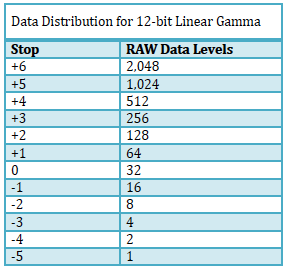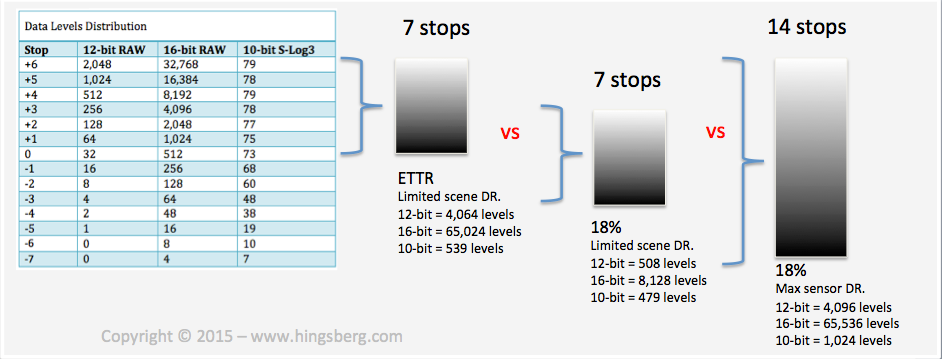
|
|
|
|||||||||
|
|
Thread Tools | Search this Thread |
|
|
#1 |
|
Trustee
Join Date: Oct 2003
Location: Toronto, Canada
Posts: 1,055
|
FS7 RAW woes & data distribution between: 12-bit RAW, 16-bit RAW, & 10-bit S-Log
I got into some interesting discussions on another forum where more than one user experienced excessive banding occurring with the FS7 using the 12-bit RAW output to the Odyssey recorder. An odd behaviour when the same issue did not seem to exist on the FS700 with 12-bit RAW output.
In the thread, I had written that with the way linear RAW works and assuming Sony's 12-bit RAW is a pure linear gamma curve there would actually not be enough data bits left at the lower end of the sensor's overall dynamic range of 14 stops. Sony would have to apply some rounding or bending of the linear gamma to help get some data bits covering the lower end of the tonal range. This table of mine helps to illustrate what I'm talking about. As everyone knows with 12-bit you have 4096 total levels of grey. The highest stop takes 2048 of these levels (so half what is available overall) and then the 2nd highest stop takes 1024 levels, the third stop takes 512 levels, and so on and so on. By the time you get to the bottom you do not have any bits left to even cover the entire dynamic range of the sensor (14 stops). You'll actually notice the table only covers the first 12 stops and doesn't even get to the 13th and 14th stops as there would be no data available for them.  16-bit RAW from the F5/F55 on the other hand seems to cover the camera dynamic range somewhat better because you're starting with 65,536 levels at the highest stop that by the time you get down to the lowest stop you still have some data levels available for it. To put everything in perspective when it comes to data distribution between 16-bit RAW, 12-bit RAW, and 10-bit S-Log3 I've put together a table to show some differences. With a scene limited to 7 stops for example, notice the difference in data levels between ETTR and exposing for 18% middle grey for both 12/16 bit RAW and for S-Log. If shooting RAW it's easy to see that ETTR gives you more bits whereas with S-Log whether you use ETTR or expose for middle grey you practically end up with the same amount of data levels ie. 479 vs 539 levels. 
|
|
|
|
|
|
#2 |
|
Trustee
Join Date: Apr 2008
Location: Sydney Australia
Posts: 1,606
|
Re: FS7 RAW woes & data distribution between: 12-bit RAW, 16-bit RAW, & 10-bit S-Log
That is indeed very interesting Dennis. I shall be keeping my ear open for further news on this. I wonder if the FS5 when it gets its RAW output option will exhibit similar behaviour? As you pointed out if it's not visible on a RAW optioned FS700, I'm sure we would have heard about it for sure I if it was... makes me wonder what may have changed along the way. Thanks for the charts. A very useful quick reference.
Chris Young CYV Productions Sydney |
|
|
|
|
|
#3 |
|
Trustee
Join Date: Oct 2003
Location: Toronto, Canada
Posts: 1,055
|
Re: FS7 RAW woes & data distribution between: 12-bit RAW, 16-bit RAW, & 10-bit S-Log
If I had to speculate yes the FS5 will have the same problem & limitation.
As for what changed between the camera's it's simply the dynamic range. ie. the FS700 was around 11-12 stops which may fit into 12-bit linear RAW somewhat better than the new camera's (FS5/FS7) which are 14 stops. For this reason on the newer camera's you might be best to stick with S-Log gamma curves if you want a higher dynamic range capture with a somewhat cleaner or more artifact free image. Convergent Design has not commented directly on this since they build the Odyssey 7Q to interface with the 12-bit RAW stream, however it would appear that the issue is with the 12-bit stream and not their recorder. |
|
|
|
| ||||||
|
||||||
|
|